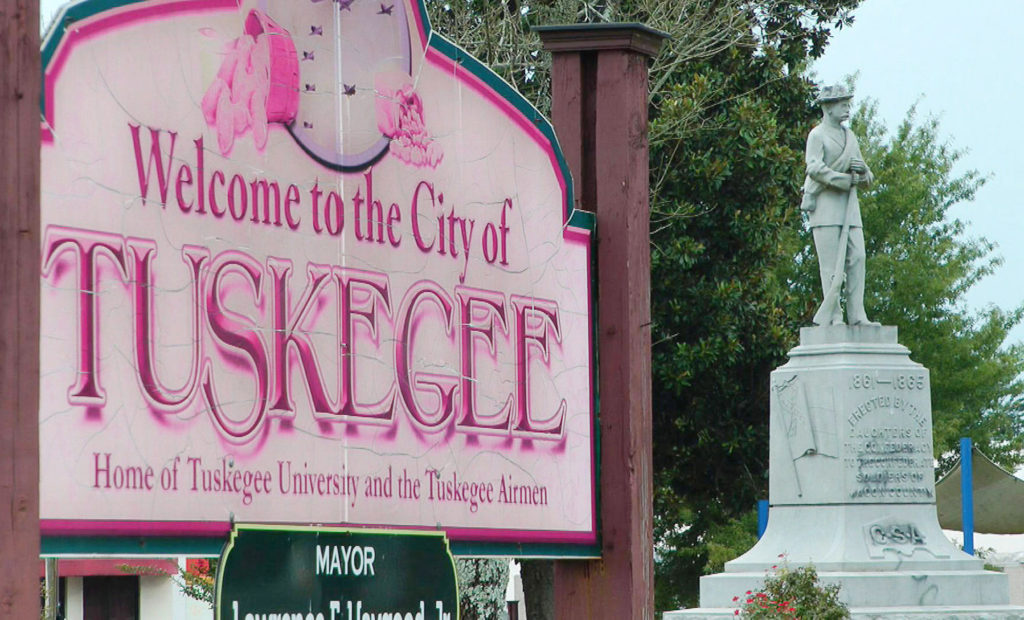History shared but unreconciled in city’s Confederate statue

In 1906, when aging, white Confederate veterans of the Civil War and black ex-slaves still lived on the old plantations of the Deep South, two very different celebrations were afoot in this city known even then as a beacon of black empowerment. Tuskegee Institute, founded to educate Southern blacks whose families had lived in bondage for generations, was saluting its 25th anniversary. Meanwhile, area whites were preparing to dedicate a monument to rebel soldiers in a downtown park set aside exclusively for white people. Flash forward to today and that same Confederate monument still stands in the same park, both of them owned by a Confederate heritage group. They sit in the heart of a poor, black-controlled town of 9,800 people that’s less than 3 percent white. Students from what’s now Tuskegee University once tried and failed to tear down the old gray statue, which has since become a target for vandals. But critics who want it gone aren’t optimistic about removing it, even as similar monuments come down nationwide. “I think it would probably take a bomb to get it down,” said Dyann Robinson, president of the Tuskegee Historic Preservation Commission. The story of how such a monument could be erected and still remain in place a century later offers lessons in just how hard it can be to confront a shared history that still divides a nation. ___ In 1860, before the Civil War began, Census records show 1,020 white people owned 18,176 black people in Macon County, where Tuskegee sits. The enslaved were mostly kept uneducated. Schooling became nearly as big a need as food and shelter once the fighting stopped in 1865. Established by the Alabama Legislature through the joint work of a freed slave and a former slave owner, the Tuskegee Normal and Industrial Institute was founded in 1881, according to the school’s official history. Booker T. Washington built it into a leading institution for educating blacks. To this day, it remains a leading historically black university. By the time of Tuskegee’s 25th anniversary, Washington was widely acclaimed for advocating practical education, character building and hard work to lift blacks from the poverty of the postwar South. William Howard Taft, who would become U.S. president a few years later, attended the celebration; so did industrialist and donor Andrew Carnegie. Coverage of the anniversary festivities in The Tuskegee News, a white-owned newspaper, emphasized that blacks needed to get along with the whites who had near total control in the old Confederate states. “Every address from northerner, or southerner, and black gave forth the unmistakable tribute to the value, yea, the absolute necessity of the southern negro doing all in his power to merit the confidence and friendly cooperation of the southern white man …,” the paper reported on its front page. ___ Meanwhile, the United Daughters of the Confederacy, composed of female descendants of Confederate veterans, was erecting monuments glorifying the “lost cause” of the South all over the region in the early 1900s. The women of the Tuskegee chapter planned one for their town. They staged a musical performance and a chrysanthemum show to raise money for a Confederate statue, according to Tuskegee News accounts. Then, two months after the Tuskegee Institute anniversary, leaders of the white-controlled county government gave the United Daughters the main downtown square to serve as a “park for white people” around a memorial to Macon County’s Confederate veterans, city records show. The monument, which included the inscribed admonition to “honor the brave,” finally was dedicated on Oct. 6, 1909. The Montgomery Advertiser called the ceremony “one of the largest masses of white people ever before witnessed in Tuskegee.” Confederate flags waved and 13 young women were dressed in crimson and white to represent the Confederate states. Newspaper stories from the time don’t say whether any blacks attended the event, which included a parade through town, but they most certainly were around. Macon County was around 82 percent black at the time, Census records show, although Jim Crow laws kept whites in firm political control. The nation’s first black combat pilots, the Tuskegee Airmen, trained in the town in the 1940s, but not until the 1960s did the civil rights movement start changing political dynamics. ___ Blacks were first elected to office in Tuskegee in 1964, but whites still controlled most of Alabama. Frustrated after an all-white jury in another county acquitted a white man accused of murder in the shooting death of a civil rights worker, blacks took out their anger on the Confederate monument in 1966. A crowd described in news reports as Tuskegee students converged downtown after jurors acquitted white gas station attendant Marvin Segrest in the killing of black Navy veteran and civil rights worker Samuel L. Younge Jr., who was gunned down after asking to use a whites-only bathroom. It took only 70 minutes or so for jurors to side with Segrest. On a night when rocks flew through windows around the town square, demonstrators went after the Confederate monument. Simuel Schutz Jr., a friend of Younge who participated in the demonstration, said protesters attached a chain or rope to the monument in a bid to pull it down, but failed. “We didn’t have a vehicle to topple it that night and that’s why it’s still there,” said Schutz, 72, now a contractor in Trenton, New Jersey. But protesters did have spray paint. The next morning, the soldier atop the monument had a yellow stripe down its back with the words “black power” scrawled on the base in black paint. First elected mayor in 1972, Johnny Ford said he tried to have the monument relocated after taking office and again in 2015. Both efforts failed, as did a few similar attempts during the intervening years. “Whites oppose moving it and older blacks didn’t want to for fear of upsetting race relations,” said Ford, now out of office after serving more than three decades both as mayor and a state representative from the area. For some,
Here are the top 10 ways the proposed 2018 Farm Bill will affect Alabama

Alabama is home to a $70 billion agriculture economy, which is why the Agriculture and Nutrition Act of 2018, H.R. 2, better known as the “Farm bill” is particularly important for Yellowhammer State farmers. The bill is headed for a vote on Friday by the U.S. House of Representatives. Already, some Alabama representatives are speaking out in support of the bill, but if passed, how will it really affect the Yellowhammer State? Alabama 3rd District U.S. Rep. Mike Rogers, the only Alabama member of the House Committee On Agriculture, issued a statement on Thursday explaining how the bill will affect Alabama’s many farmers. “The truth is that the agriculture industry makes up over 40 percent of the economy in the State of Alabama,” said Rogers. “Every five years, Congress has to renew the Farm Bill and the policies that are critical to setting the guidelines for our farmers and producers.” Rogers continued to say that the Farm Bill will reform the Supplemental Nutrition Assistance Program (SNAP) by encouraging individuals to get work or free training to help pull themselves out of poverty; a condition that will only apply to able-bodied adults. The bill will also help bring higher quality broadband service to rural areas in the State by incentivizing providers. “I was also pleased my amendment was included, the SNAP Vitamin and Mineral Improvement Act,” Rogers said. “It would allow low-income Americans to purchase a daily multivitamin-mineral supplement with their SNAP benefits to make sure they are getting their daily nutrients and add choices to SNAP while not changing the costs.” Top 10 ways the 2018 Farm Bill affects Alabama: Farm policy: ARC and PLC. The bill reauthorizes and strengthens the Agriculture Risk Coverage (ARC) and Price Loss Coverage (PLC) options through 2023. Producers are given an opportunity to make a new election between ARC and PLC with several improvements, including allowing a new yield update opportunity for producers who were facing severe drought during the previous yield update, allowing reference prices to adjust to improved market conditions, and prioritizing the use of RMA data for administering ARC to minimize disparities between counties. Nutrition. Over 35 improvements are made to the Supplemental Nutrition Assistance Program (SNAP), the nation’s flagship nutrition program. Most notably, existing work requirements are strengthened, streamlined and paired with a variety of options to increase opportunities for SNAP recipients, including participating in a fully-funded, guaranteed Employment & Training (E&T) slot. Individuals may choose not to participate, but they will no longer be eligible for SNAP. The Farm Bill would not kick 1,000,000 SNAP recipients off the program: Anyone who would leave the program would do so because they have obtained employment with sufficient income and are no longer be eligible or they choose not to work or participate in a work or training program for at least 20 hours per week. No one would be kicked off SNAP due to a mandatory work requirement. The bill would not enforce work requirements on the disabled, the elderly, expectant mothers, caretakers of children or children: Any able-bodied adult on government assistance should be working at least 20 hours per week. SNAP is a tool to bring individuals and families out of poverty using the work requirements and training program. Dairy policy. The Margin Protection Program is renamed the Dairy Risk Management (DRM) program. The first 5 million pounds of milk production on a dairy is made eligible for higher coverage levels at lower premiums. Milk production not covered under DRM is made fully eligible for a comparable crop insurance policy. Finally, feed costs are studied to ensure accuracy in the DRM, and class I milk calculations are adjusted to help dairy farmers better manage risk in the futures market. Trade. Given escalating use of illegal trade actions by foreign countries, the farm bill stands by Alabama’s farmers and ranchers, providing a strengthened safety net and authorizing and restoring funding for vital tools for trade promotion and market development. The farm bill also maintains long-standing legal authority for the secretary to provide assistance to farmers and ranchers affected by unfair foreign trading practices. Establishes an International Market Development Program. Maintains and strengthens the program purposes of the Market Access Program (MAP), the Foreign Market Development (FMD) Program, the Technical Assistance for Specialty Crops (TASC) Program, and the Emerging Markets Program (EMP), bringing these initiatives under the single umbrella of a $255 million per year International Market Development Program, with no less than $200 million for MAP, no less than $34.5 million for FMD, $10 million for EMP, and $9 million for TASC. Conservation. The farm bill prioritizes working-lands conservation by retaining and folding the best features of the Conservation Stewardship Program (CSP) into the nation’s flagship incentive-based program for voluntary conservation—the Environmental Quality Incentives Program (EQIP). This supports and enables a significant investment in emerging conservation practices like the use of cover crops Crop insurance. At the request of virtually every farmer, rural banker and rural business in the country, the farm bill enhances and protects crop insurance. According to the Ag Committee, “some improvements are made but, overall, the farm bill doesn’t fix what isn’t broken.” Rural development. Rural areas of Alabama lack the same access to broadband and infrastructure that urban areas do. The bill authorizes substantial annual appropriations for rural broadband and requires USDA to establish forward-looking broadband standards. The farm bill also strengthens the suite of rural development initiatives to promote jobs and economic activity in rural Alabama where employment is suffering due to the sharp downturn in the farm economy. Tackling the opioid crisis. Provides the secretary the authority to prioritize projects that help communities meet the challenges of the opioid crisis. Funds projects that provide access to telehealth services and build medical facilities in rural communities. It also provides a 33 percent ($25,000,000) increase in authorized funding for critical telehealth grants under the distance Learning and Telehealth Program. Beginning farmers and ranchers. The bill maintains several provisions to help beginning farmers and ranchers establish themselves in agriculture. The bill establishes a scholarship program at
Women of influence: Alabama State Rep. Pebblin Warren

Tuskegee Democrat, State Rep. Pebblin Warren has a whole lot of irons in the fire. On top of being an Alabama state representative, she serves on the Tuskegee University Board of Trustees and holds top positions in numerous professional organizations and aid groups. Last week, she was appointed vice-chair of the Lee County Delegation, and she is a member of several House committees, including: Rules, Ways and Means General Fund, Health, and the Lee County Legislation committees. Warren is also a member of the Central Alabama Works board. Needless to say, Warren is a very busy woman. Her success in serving the state has been built upon a foundation of education. She graduated from Tuskegee University in 1974 with a B.S. Degree in Business Administration and she also holds a M.Ed. degree in Personnel Administration from Tuskegee University along with a certificate of Business from the University of Notre Dame Graduate Division. She took her look of education to the workplace and started working in higher education in 1974 in the School of Veterinary Medicine at Tuskegee. She made her way up the food chain to the Director of Financial Aid at the University, until she transitioned to the Alabama Department of Postsecondary Education as the Director of Student Services, Trenholm State Technical College, and as director of Economic Development/Internal Financial Aid Auditor. She spent the majority of her, long distinguished career in higher education at the Alabama Industrial Development Training (AIDT) where she focused on the job readiness program in Macon County and getting Macon County involved in the Regional 5 Workforce Development. She retired in November 2015 to focus on her work in the state legislature. “I have been blessed to have worked consecutively for 40 years and six months,” Warren told the Tuskegee News ahead of her retirement. “I have not been laid off since I started working. And I thank God for my blessings.” In her spare time, Warren gives back to her community. She serves as an Elder at Westminster Presbyterian Church, is Vice-President of Democrats of the 82nd District Macon County Chapter, and a member of the Delta Sigma Theta Sorority. She also serves on the Board of Directors for Aid To Inmate Mothers; a non-profit organization whose mission is to “provide services to Alabama’s incarcerated women with emphasis on enhancing personal growth and strengthening the bonds between inmate mothers and their child” just to name a few. One of Warren’s most recent accomplishments was the House approval of her day care bill, HB76. The bill, which died in the Senate last year, would make background checks and yearly inspections by the Alabama Department of Human Resources a requirement for faith-based day car centers in Alabama for the protection and benefit of the children. It’s no wonder Warren received a plethora of awards and accolades including throughout her life such as: Outstanding Volunteer Service Award, Aid to Inmate Mothers, John H. Buchanan, Jr. Distinguished Service Award, Judge and Banquet Speaker, 1998 Buffalo Rock, James C. Lee Student of the Year Scholarship Program, Outstanding Service Award, Alabama College System Deans of Student Affairs Association, Montgomery Advertiser Community Volunteer Profile, Macon County Cancer Relay for Life, Habitat for Humanity, and Tutwiler Prison Volunteer. Warren is a woman of great ambition, she has worked her way through the ranks to become a key player in higher education, economic development and an impressive member of the Alabama legislature. She is an excellent asset to the state of Alabama, and a true woman of influence.
Italian ambassador visits Tuskegee to support Leonardo T-100 project

Italian Ambassador Armando Varricchio and Leonardo DRS Chief Executive William Lynn III on Monday visited the historic home base of the Tuskegee Airmen, where the aerospace company wants to manufacture the U.S. Air Force’s next-generation trainer aircraft. If Leonardo’s T-100 jet trainer is selected by the Air Force, the company plans to build a manufacturing facility at Moton Field, where the celebrated Tuskegee Airmen trained before being deployed to Italy in World War II. The project will create 750 jobs in Tuskegee. Varricchio said he was impressed by the community’s eagerness to see the T-100 project become a reality. “I can tell you that it is my first visit here, but it will not be my last,” he said during a lunch with community leaders. “I will spare no effort because we want Tuskegee to be not just a place of memory but a place of the future. “Let’s move ahead,” he added. “Let’s work together.” Job-creation engine With an Air Force decision expected in the summer, Lynn said Leonardo DRS is prepared to launch the T-100 program quickly once the aircraft is selected. The Leonardo trainer is already being used by the air forces of Israel, Poland, Singapore and Italy, and it’s complemented by a sophisticated, integrated ground-based simulation system. “It would create jobs all across the U.S.,” Lynn said. “The engines would be built in Arizona. The training simulators would be built in Florida. We have suppliers in almost every state, so it would be thousands of jobs.” Last November, Leonardo officials told an Alabama delegation visiting the company’s Italian manufacturing plant that preparations for the Tuskegee facility were on track. After their Tuskegee visit, Varricchio, Lynn and a Leonardo team traveled to Montgomery for talks with Gov. Kay Ivey and Commerce Secretary Greg Canfield, followed by a dinner. Long-standing bonds Varricchio said he sees the Leonardo project as a way to “connect the dots that are linking Italy and the United States.” While in Tuskegee, the ambassador toured a museum dedicated to the accomplishments of the Tuskegee Airmen, who were based at an airfield in Ramitelli during their stay in Italy. “I was very moved walking around in the beautiful museum that was retracing the memory of those heroes, those brave men who are not forgotten in Italy,” he said. “What they did when they came to Italy, during those difficult times, that was the moment that bonds were created – and those bonds are more present than ever.” This story originally appeared on the Alabama Department of Commerce’s Made in Alabama website. Republished with permission from the Alabama NewsCenter.
Video: How T-100 trainer jets would be manufactured in Alabama

Curious about how global aerospace company Leonardo’s Alabama workforce would manufacture the U.S. Air Force’s next-generation trainer aircraft if it’s picked for the role? Leonardo announced plans in March for an advanced manufacturing center in Tuskegee for its T-100 trainer jet, one of the contenders in an Air Force competition to replace its aging fleet of T-38 aircraft. In November, an Alabama delegation got a first-hand look at how Leonardo manufactures advanced training aircraft during a tour of a company factory in Italy. A fast-paced video from Leonardo DRS shows how T-100s would be manufactured at the Alabama facility. Greg Canfield, secretary of the Alabama Department of Commerce, led the delegation of state and Macon County officials who traveled to Leonardo’s aircraft manufacturing facility in Venegono Superiore in mid-November. While there, the Alabama group received a briefing from Leonardo executives who said preparations for the Tuskegee manufacturing center are on track. Canfield said the aircraft factory would have a massive economic impact on Macon County and the surrounding area. “The T-100 factory would create an anchor for a new aviation manufacturing industry in Tuskegee with high-paying jobs and tremendous long-term growth prospects,” he said. “It’s not an exaggeration to say the Leonardo facility would create new opportunities for citizens and businesses in Macon County that would change the trajectory of the entire region.” Historic location Leonardo’s manufacturing center would be built at Moton Field, where the celebrated Tuskegee Airmen fighter pilots trained during World War II. Leonardo’s twin-engine M-346 aircraft is already being used to train pilots to fly next-generation fighter aircraft. The T-100 is based on the proven M-346, which has been selected for a training role by Italy, Israel, Singapore and Poland. Leonardo said its project in Tuskegee calls for the creation of 750 full-time jobs. An Air Force decision on the trainer jet competition is expected next spring. This story originally appeared on the Alabama Department of Commerce’s Made in Alabama website. Republished with permission from the Alabama NewsCenter.
Alabama aerospace industry gains velocity with new investment

Alabama’s aerospace and aviation industry is recording a landmark year, with a major haul of project announcements that bring the promise of international prominence to communities and workers across the state. So far this year, aerospace companies have unveiled plans to invest at least $500 million and bring more than 2,200 jobs to Alabama in new facilities or expansions of existing operations. That follows another solid year of growth for the industry in 2016, when project announcements involved $260 million in new investment and 2,000 additional jobs. “Alabama has long been a major player in designing and manufacturing the most innovative, complex solutions to conquer skies and space, and we are continuing to shape the global industry today,” said Greg Canfield, secretary of the Alabama Department of Commerce. “Companies around the world know our workforce has proven itself, time and time again, and that’s why they keep turning to this state to help solve modern industry challenges and achieve the latest groundbreaking work,” he added. Leonardo in Tuskegee One of this year’s major announcements came from global aerospace and defense firm Leonardo, which plans to build the T-100 jet trainer at Tuskegee’s Moton Field if it wins a U.S. Air Force contract for a next-generation training aircraft. The project calls for the creation of 750 jobs over a 10-year period beginning in 2019. The potential opportunity for Tuskegee and the surrounding area is huge, and it would add a new chapter to the region’s aviation legacy. Moton Field is where the legendary Tuskegee Airmen trained during World War II. Canfield led an Alabama delegation that last week met with Leonardo executives and toured a factory in Italy where the company manufactures jet trainer aircraft. The objective of the mission was to help advance preparations under way in Alabama for the development of the manufacturing facility at Moton Field. Rocket engines Other key 2017 announcements include a pair of new rocket engine factories in Huntsville. Blue Origin, the spaceflight company started by Amazon founder Jeff Bezos, plans to manufacture its BE-4 engine in a new $200 million, 342-job facility. At the same time, Aerojet Rocketdyne is expanding its Huntsville operation with plans for 800 jobs and a new manufacturing plant for its ARI rocket engine and other parts. The companies cite Alabama’s skilled workforce and industry prominence. “Alabama is a great state for aerospace manufacturing and we are proud to produce America’s next rocket engine right here in the Rocket City,” Robert Meyerson, president of Blue Origin, said at the time of the company’s project announcement. “The area’s skilled workforce and leading role in rocket propulsion development make Huntsville the ideal location for our state-of-the-art manufacturing facility.” Aerospace clusters Elsewhere in the state, more industry breakthroughs are on the horizon. GE recently selected Auburn University as one of eight universities in the world to participate in an innovative program focusing on 3-D printing research and education initiatives. Nearby, the GE Aviation plant in Auburn is using additive manufacturing to mass produce fuel nozzle injectors. The company says the nozzle is the first complex jet engine component produced with 3-D printing technology. And Airbus, which builds its A320 Family aircraft at its $600 million plant in Mobile, said last month that it will partner with Canadian manufacturer Bombardier to bring a new production line for Bombardier’s C Series passenger jets to Alabama. Aerospace has been an important contributor to Alabama’s economy for decades, and in recent years the state has emerged as a top location for companies that are global leaders in the industry, said Steve Sewell, executive vice president of the Economic Development Partnership of Alabama. “In addition to major industry clusters in Huntsville and Mobile, we now have aviation and aerospace-related companies providing advanced manufacturing and engineering jobs in communities throughout the state,” he said. “One of Alabama’s great strengths in aerospace is the diversity of sectors that are represented here, including aircraft assembly, rocket propulsion, precision component manufacturing, missile defense and maintenance, repair and overhaul.” Sewell said the latest aerospace projects planned for Alabama will further cement the state’s legacy in the sector. “The recent investments and the continued growth and success of the aerospace industry have enhanced Alabama’s reputation as a state that can support the most advanced level of manufacturing,” he said. This story originally appeared on the Alabama Department of Commerce’s Made in Alabama website. Republished with permission from the Alabam NewsCenter.
Tuskegee mayor: T-100 manufacturing facility will lift region

Sitting in the back seat of an F-16 jet on a flight over Tuskegee, Mayor Tony Haygood looked down at Moton Field and envisioned the historic airfield’s future as the production site of the U.S. Air Force’s next jet training aircraft. “From that height, it is amazing how you can see the whole layout of things at Moton Field and where the runway expansion would be,” Haygood said. “There’s plenty of space for it, and we’ll be doing some other improvements.” Earlier this year, global aerospace company Leonardo selected Moton Field as the manufacturing site for its T-100 advanced trainer jet if the Air Force chooses the aircraft as its next-generation trainer. The project would bring 750 jobs to the airfield where the pilots of the Tuskegee Airmen received their training. Haygood, who is traveling to Italy with an Alabama delegation to tour a Leonardo aircraft factory this week, said an in-depth look at the company’s manufacturing operation will assist Macon County’s preparations for the Tuskegee facility. “This is like advance preparation that gives us an opportunity to see, hear and understand how we need to get ready,” he said. Made In Alabama caught up with Haygood in Tuskegee before the Alabama team departed so he could share his insights on the Leonardo T-100 jet trainer project planned for Moton Field. Here’s what he said. Q: What would the Leonardo T-100 manufacturing facility mean for Tuskegee and the region? A: It would be a tremendous boost to this community. For Tuskegee, it would be the largest project we’ve had in our history. It would be a big boost for the entire economy of south central Alabama and would impact the entire state as well. For us, it would mean high-quality jobs, and it would trigger a revitalization of our entire economy. Q: How have Tuskegee and Macon County been preparing for a project of this magnitude? A: We have been working within the region, with Auburn, Montgomery and other cities, to position ourselves as a viable site for economic development. Having the runway at Moton Field, and the space around it, allows us to pursue this project. We’re capable of expanding the runway to 8,000 feet. We have water service at the site. We have a major interstate – I-85 — right there and CSX railway there. So we have the basic ingredients in terms of transportation and location. Q: Can the area provide the workforce for the Leonardo T-100 facility? A: We can provide a quality workforce, and we will have assistance from the state. Go back to the Tuskegee Airmen. People didn’t think they could fly advanced aircraft, but given the opportunity and the training, they not only flew, they excelled. It’s really the same story today. Give people the opportunity, give them the support, and we can develop the workforce and the expertise that is needed. Click here to read more. Republished with permission from the Alabama NewsCenter.
Longtime Tuskegee Mayor Johnny Ford loses re-election bid

Tuskegee Hills will have a new mayor. City councilman Tony Haygood won the Aug. 23 municipal election with 62 percent — 1,401 votes to 865 — over longtime incumbent Johnny Ford. Haygood currently serves as the city’s councilman at large and mayor pro tem. As the new mayor, he says he wants to work on financial stability, revitalizing downtown, strengthening the relationship between the city and Tuskegee University, and make sure the city will be financially stable. Outgoing mayor Ford was first elected mayor of Tuskegee in 1972 and has served in the office for 32 of the last 44 years. He also served as a state representative. “I would like to thank all of my faithful supporters, volunteers, and all of the citizens of Tuskegee who voted for me, and who worked so hard to allow us to finish the job that we have begun moving Tuskegee forward,” said Ford. “I am proud of, and grateful for, the opportunity that I have had to serve Tuskegee as mayor through the years. “I congratulate Mayor Pro tem Lawrence ‘Tony’ Haygood, on his victory, and wish him the best as the mayor of historic Tuskegee, Alabama, the home of Tuskegee University, ‘The Pride of the Swift Growing South.’”


